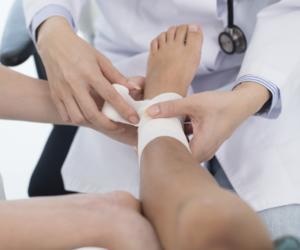5 Tips to Prevent Shin Splints

What are shin splints?
Shin splints are characterized by pain along the inner portion of the shin bone (the long bone below the knee). Shin splints are also known as medial tibial stress syndrome (MTSS). They commonly occur in people who participate in strenuous physical activities and sports such as tennis, soccer, and basketball.
Shin splints can occur due to various reasons, ranging from training with poor form, to running frequency, to poorly-fitted shoes. These reasons can cause shin splints and make them worse. That is why you need to take extra care when playing sports or indulging in any strenuous physical activity by ensuring that you are wearing the right gear, the right shoes, and have good form.
Many people do not take proper care of their shins until they begin to hurt. Studies have shown that shin splints most commonly occur in new runners, so prevention techniques are important and the most effective way to avoid shin splints altogether. These shin splints can get progressively worse if left untreated and this is why it is a good idea to prevent them from occurring in the first place. When new runners start to practice, they stress out the body and with poor form, along with inadequate gear including shoes, they are susceptible to developing shin splints.
Shin splints have been known to keep athletes away from sports for roughly about 72 days, a very unpleasant period of pain and recovery for anyone. At times, the pain can be so unbearable that you may even find it hard to walk a few steps, which is why it is important to avoid these splints from happening.
How can I prevent shin splints?
Here are some tips that can help avoid MTSS:
1. Strengthen your lower body
Shin splints are common when people overexert themselves. The shin bone is supported by the feet, ankles, calf muscles, and hips. So if these areas are weak, then all the weight that should be supported by them falls on the shins, causing lots of stress to the area. Therefore, strengthening your lower body will help you in preventing shin splints.
That is why it is essential that you take part in fitness exercises, and exercise your body on a regular basis. You need to strengthen your lower body so that your weight is better distributed, thereby ensuring that your shin bone is not under any undue stress. You need to maintain a tight fitness discipline and even go in for a better healthy diet--one that can help your body recover from injuries quickly, including shin splints.
And with good fitness workouts, you should be able to ensure that your body weight is evenly distributed and that your legs can support your body better. Here are a few exercises that you can do to strengthen your lower body, and thus, help reduce shin splints:
- Heel Drop – Stand on your toes on the edge of a step. Next, lower the back of your feet while shifting your weight to your toes, so your heels fall below the step and you are still on your toes on the step. Then, lift your heels all the way up so you are standing up on your toes again. Repeat this exercise. This should enable you to exercise your heel and enable your feet to support your body better without getting stressed. This should be effective in preventing shin splints from occurring in the first place.
- The Monster Walk – Place your feet shoulder-width apart and wear a resistance band around your thighs. Next, move your right leg forward and to the right. Do the same with your left leg, moving the left leg forward and to the left. Repeat this process. This should enable you to develop your lower body and prevent shin splints.
- Toe Curls – Stand with your feet about hip-width apart at the edge of a towel. Next, grab the towel using the toes of your right foot and pull it towards you. Do the same with the opposite foot and repeat the exercise. This should further strengthen your toes as well as your heel and should enable your feet to support your body better.
2. Do not increase the intensity all at once
Always increase the intensity of your workouts gradually. For example, if you are a runner, increase your distance and speed slowly without making sudden increments in the distance and speed you run. Running too much or too soon is considered to be one of the main causes of shin splints. To avoid running too much or too soon, you should instead try to increase your speed and distance gradually to put your shins under the least amount of pressure as possible.
For new runners, it is recommended that they do not overdo it by suddenly running many miles in one go. They should make sure that they take regular break periods in their training or running schedules. It is essential that you train at a pace that you are comfortable at, and when running, make sure that you try out a few stretching exercises prior to the run itself.
This should enable you to stretch out those muscles so that they do not get stressed too much during the run. More importantly, it is vital that you set out a pace you are comfortable with and that you do not increase the speed all of a sudden, which can result in shin splints as well as muscle cramps. The pain from such injuries can be excruciating, making it hard for you to even walk a few steps.
It is vital that you train at a pace that is comfortable and try to increase the pace of your workouts at a steady rate. When running, increase your speed gradually without unduly stressing your body to its limit. That is why it is essential that you try working out on a regular basis, enabling you to keep your body fit while developing your overall strength.
Another way to reduce pressure is by combining different forms of cardio. Try switching between running and walking during your workout. If you're at the gym, try switching between a treadmill and an elliptical machine or bicycle. Also, rather than going from not working out at all to every day, start with every other day. Training gently, massaging, and icing your calf muscles, or just taking a break day and cross training with the help of other sports, can help prevent shin splints as well as other injuries.
In short, to keep fit, you need to increase the activities on a regular basis. Trying a marathon and long workout sessions in one go are only going to result in your muscles and the remainder of your body getting strained further, which can even lead to shin splints. So set the pace, increase it gradually, and more importantly, try not to overdo it whether you are exercising or carrying out some other strenuous physical activities.
3. Wear comfortable and stable shoes
Do not run barefoot or wear worn-out shoes. Shin splints can result from this because you lack proper arch support. Choose a pair of shoes that is comfortable, has stability with motion-controlling properties, and proper arch support. You can even go for a good neutral shoe. This will prevent your ankles from rolling or overpronating and cause stress on the shins.
If you are unsure about your arch and shoes, you can always consult a doctor as he would be in a better position to advise you regarding arches.
One of the easiest ways to minimize the risk of having shin splints is often just walking barefoot. Runners or athletes suffering from shin splints are also advised to change their shoes every so often and when warranted. Running in shoes that have been worn out is also one of the most common causes of shin splints. It is advisable to replace your shoes after having clocked in 300 miles on them or every year if you do not run that much.
Remember proper foot support is essential to prevent shin splints, so make sure that whatever footgear you are using at the moment, it should comfortably ensconce your feet and support your arches. It is important that your shoe enables your feet to support your weight and keeps it well-distributed so that no part of your body gets unduly stressed.
4. Strike the ground with the balls of your feet
Landing on your heels when running forces your feet to hit hard against the ground, causing your shin and foot muscles more stress. Landing on your toes can cause stress to your calf muscles. Hitting your feet heel first can cause the foot to slap down on the road or pavement, and thus, cause stretching to the shin muscles. This can cause the shin muscles to work harder, thereby slowing them down.
The best way to run is by hitting the ground with the middle or balls of your feet while running to avoid strained muscles and shin splints. On the other hand, even running on your toes can cause stress to your calf muscles in the back of the legs and can cause splints. Therefore, a correct and proper gait is essential in preventing shin splints and injuries.
If you are still unsure about the proper way to run without unduly stressing your body out, you can always consult your coach or trainer, who would be better suited to advise you when it comes to the proper way to run. With the right posture or form, you should be able to avoid shin splints. It is important that you learn the right way to carry out any physical activity from running to working out to avoid causing your body any further distress.
5. Use orthotics
If you are prone to heel striking or overpronating, then replacing your shoe’s foam liner with plastic orthotics can help you by providing you with additional arch support. Orthotics is a type of custom-made foot bedding that helps to realign your foot into a natural position. They also support your feet by redistributing the force of running or walking evenly.
Orthotics will, therefore, remove the stress on your feet, legs and shins, and help you avoid a lot of problems. They can help you treat and even prevent shin splints. Your local running store can assist you with form-fitted orthotics to help with your shin splints.
There are many shoes that you can use when recovering from shin splints. The recovery process can take a while, but with the right care and support in the form of comfortable footgear, you should be able to return back to your normal life as soon as possible. Orthotics can help you achieve a quicker recovery and even help you develop better strength in your legs. This, in turn, can prevent a reoccurrence of shin splints.
It is vital that you do not overdo when undertaking any physical activity including playing sports, as it can cause your body to get stressed beyond the norm. This will result in you developing everything from muscle cramps to shin splints. The recovery time for the latter can vary from one case to another, but the moment you experience the symptoms, it is vital that you contact your doctor right away, so that he can help alleviate the pain and treat it effectively.
If left untreated, the pain can get progressively worse and can even cause you several health complications. So it is important that you check in with your doctor the moment you start experiencing some of the pain for a speedy relief and treatment.













